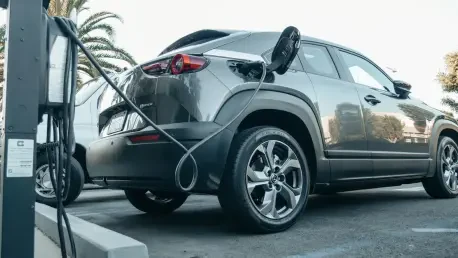The rise in electric vehicle (EV) ownership has brought not only environmental benefits but also new challenges for the insurance industry, particularly concerning vehicle replacements. As an increasing number of drivers make the switch from internal combustion engine (ICE) vehicles to EVs, insurers find themselves under pressure to adapt their policies and services to meet these drivers’ expectations. One key issue is the provision of replacement vehicles during repair periods, an expectation that many insurers currently struggle to meet. This gap between customer expectations and actual service highlights the broader challenges that accompany the transition to electric mobility.
The Expectation-Reality Mismatch
Evolving Customer Expectations
The growth of the EV market has brought a significant shift in consumer expectations. A recent survey indicates that 89% of EV owners now expect a like-for-like EV replacement when their vehicle is undergoing repairs. This expectation is rooted in various factors, including the environmental values of EV owners and the practical benefits of driving an EV.
However, current statistics show that only 65% of EV owners have received an EV replacement after an accident. This disparity poses a substantial risk to insurers regarding customer satisfaction and retention. In a market where customer loyalty can be as critical as policy pricing, meeting these expectations is more than a nicety; it is essential.
Navigating Fleet and Salary Sacrifice Schemes
Another layer of complexity is added by ‘salary sacrifice’ schemes and fleet customers. These clients often face ‘benefit in kind’ tax implications, which are stirred by the provision of an ICE replacement vehicle. Such tax implications make it financially pressing for these drivers to receive EV replacements. The gap between available replacements in body shops and what is required by fleet customers exacerbates the problem. Body shops often resort to providing whatever vehicle is available, which does not always meet the needs of these specialized clients.
This misalignment creates challenges not just for the customers but also for the insurers who strive to rebuild trust and satisfaction amidst an evolving market. Furthermore, it heightens the need for a more structured approach to ensure the availability of appropriate replacement vehicles.
Addressing the Supply Chain Challenges
Strengthening Partnerships with Rental Companies
One of the vital strategies proposed to address these issues is strengthening partnerships with rental companies that possess extensive EV fleets. Insurers need to form alliances with companies that can provide the necessary volume and diversity of EVs to meet customer demand. These partnerships help alleviate the supply chain pressure, ensuring a more consistent availability of EV replacements.
Moreover, rental companies with established EV networks can offer logistical advantages that streamline the process of providing replacements. By leveraging these networks, insurers can better match the supply of EVs with the needs of various customer segments, including those under fleet and salary sacrifice arrangements. This approach not only improves the replacement vehicle experience but also enhances overall customer satisfaction.
Investment in Aftermarket and Technician Training
A critical aspect often overlooked is the necessity for a highly trained workforce capable of handling the specific needs of EVs. The aftermarket sector must invest in extensive training programs for technicians and handlers specializing in EVs. Such training ensures that the service provided aligns with the technical demands of modern electric vehicles.
Training programs might include advanced diagnostic techniques, understanding of EV-specific components, and safety protocols. Insurers must recognize the value of this skilled workforce in providing quality replacement vehicles and minimizing downtime. This investment not only addresses current shortages but also future-proofs the industry against evolving technological advancements in vehicle design and functionality.
Future Considerations for Insurers
Bridging the Accessibility Gap
As the EV market continues to expand, insurers will need to devise comprehensive strategies to bridge the accessibility gap for replacement vehicles. This process includes evaluating the current fleet capabilities, investing in EV-centric infrastructure, and ensuring that policies reflect the evolving landscape. It’s clear that the one-size-fits-all model no longer applies; insurers must offer customized solutions tailored to diverse consumer segments, from individual EV owners to extensive corporate fleets.
Additionally, insurers should look into real-time data analytics to better understand and foresee the demand for EV replacements. Predictive models can help in resource allocation, ensuring that replacements are readily available when needed. Utilizing technology to forecast trends and adjust operational strategies accordingly will be crucial in staying ahead in this rapidly evolving market.
Enhancing Customer Care
To ensure a positive customer experience, insurers should also focus on enhancing customer care throughout the claims process. Transparency, efficient communication, and prompt service are critical elements that can significantly influence customer perceptions. By prioritizing these areas, insurers can mitigate dissatisfaction and foster lasting trust.
Technology can play a pivotal role in this regard. Implementing digital platforms for claims management, providing real-time updates to customers, and employing customer service automation can streamline processes and improve interactions. Investing in these areas not only addresses current challenges but also aligns with broader industry trends leaning towards digital transformation and customer-centric approaches.
Conclusion: Paving the Way Forward
The increasing ownership of electric vehicles (EVs) has led to both environmental advantages and fresh challenges for the insurance sector, particularly in the arena of vehicle replacements. As a growing number of motorists transition from internal combustion engine (ICE) vehicles to EVs, insurers are feeling the strain to revamp their policies and services to cater to this demographic. A significant issue is the availability of replacement vehicles during periods when the EV is being repaired. Many insurers are presently falling short of meeting this expectation, which emphasizes the broader array of challenges linked to the move towards electric mobility. This disparity between what customers desire and what insurers can currently provide underscores the need for immediate action and innovation within the industry. Insurers must now work to address these emerging needs to avoid lagging behind in an ever-evolving automotive market.









